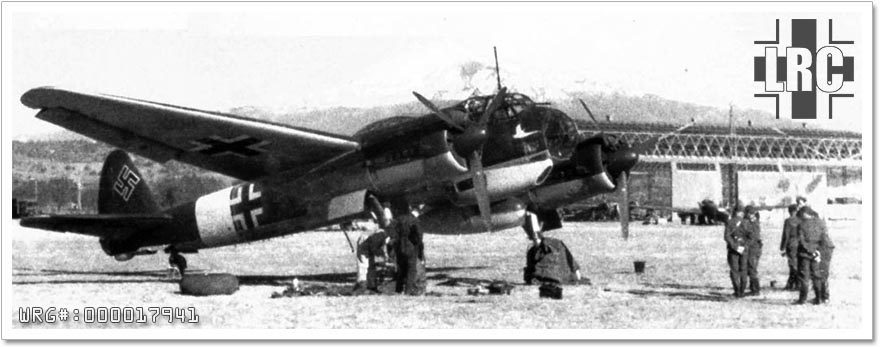Junkers Ju 88
Design & Development
In August 1935, the Reichsluftfahrtministerium submitted its requirements for an unarmed, three-seat, high-speed
bomber, with a payload of 800-1,000 kg (1,760-2,200 lb). Junkers presented their initial design in June 1936,
and were given clearance to build two prototypes (Werknummer 4941 and 4942). The first two aircraft were to have
a range of 2,000 km (1,240 mi) and were to be powered by two DB 600s. Three further aircraft, (Werknummer 4943,
4944 and 4945), were to be powered by Jumo 211 engines. The first two prototypes, Ju 88 V1 and V2, were
different from the V3, V4 and V5 in that the latter three models were equipped with three defensive armament
positions to the rear of the cockpit, and were able to carry two 1,000 kg (2,200 lb) bombs under the inner
wing.

Junkers Ju 88A having a tire changed, Sicily, 1942.
[Source: Unknown]
The first five prototypes had conventionally-operating dual-strut leg rearwards-retracting main gear, but starting
with the V6 prototype, a main gear design that twisted the new, single-leg main gear strut through 90°
during the retraction sequence debuted, much like the American Curtiss P-40 fighter design used. This feature
allowed the main wheels to end up above the lower end of the strut when fully retracted and was adopted as
standard for all future production Ju 88s, and only minimally modified for the later Ju 188 and 388 developments
of it. These single-leg landing gear struts also made use of stacks of conical Belleville washers inside them,
as their main form of suspension for takeoffs and landings.
By 1938 radical modifications from the first prototype began to produce a "heavy" dive bomber. The wings were
strengthened, dive brakes were added, the fuselage was extended and the number of crewmembers was increased to
four. Due to these advances, the Ju 88 was to enter the war as a medium bomber.
The choice of annular radiators for engine cooling on the Ju 88, which placed these radiators immediately forward
of each engine, and directly behind each propeller, allowed the cooling lines for the engine coolant and
oil-cooling radiators (integrated within the annular design) to be just about as short as possible. The concept
may have led to a number of other German military aircraft designs adopting the same solution, such as the
Arado Ar 240, Heinkel He 177, Heinkel He 219, the inline powered developments of the Focke-Wulf Fw 190 and
the twin engined Focke-Wulf Ta 154.
The aircraft's first flight was made by the prototype Ju 88 V1, which bore the civil registration D-AQEN, on 21
December 1936. When it first flew, it managed about 580 kph (360 mph) and Hermann Göring, head of the
Luftwaffe was ecstatic. It was an aircraft that could finally fulfill the promise of the Schnellbomber, a
high-speed bomber. The streamlined fuselage was modeled after its contemporary, the Dornier Do 17, but with fewer
defensive guns because the belief still held that it could outrun late 1930s-era fighters. The fifth prototype
set a 1,000 km (620 mi) closed-circuit record in March 1939, carrying a 2,000 kg (4,410 lb) payload at a speed
of 517 kph (320 mph). However, by the time Luftwaffe planners had had their own "pet" features added (including
dive-bombing), the Ju 88's top speed had dropped to around 450 kph (280 mph). The Ju 88 V7 was fitted with
cable-cutting equipment to combat the potential threat of British barrage balloons, and was successfully tested
in this role. The V7 then had the Ju 88 A-1 "beetle's eye" faceted nose glazing installed, complete with the
Bola undernose ventral defensive machine gun emplacement, and was put through a series of dive-bombing tests
with 250 kg (550 lb) and 500 kg (1,100 lb) bombs, and in early 1940, with 1,000 kg (2,200 lb) bombs.
The Ju 88 V8 (DG+BF, Wrk Nr 4948) flew on the 3 October 1938. The A-0 series was developed through the V9
and V10 prototypes. The A-1 series prototypes were Wrk Nrs 0003, 0004 and 0005. The A-1s were given the
Jumo 211B-1 or G powerplants.
Dr. Heinrich Koppenberg (managing director of Jumo) assured Göring in the autumn of 1938 that 300 Ju 88s per
month was definitely possible. Göring was in favour of the A-1 variant for mass production.
Production was delayed drastically with developmental problems. Although planned for a service introduction in
1938, the Ju 88 finally entered squadron service (with only 12 aircraft) on the first day of the attack on
Poland in 1939. Production was painfully slow with only one Ju 88 manufactured per week, as problems
continually kept cropping up. The Ju 88C series of heavy fighter was also designed very early in 1940, but kept
secret from Göring, as he only wanted bombers.

Junkers Ju 88A having a tire changed, Sicily, 1942.
[Source: Unknown]
Sources:
Gunston, Bill - The Encyclodepia of the Worlds Combat aircraft, 1976, Chartwell Books, Inc., New York
Brown, Eric, Captain - Wings of the Luftwaffe , 1979, Airlife Publishing Ltd., Shrewsbury
, 1979, Airlife Publishing Ltd., Shrewsbury
Gunston, Bill & Wood, Tony - Hitler's Luftwaffe , 1977, Salamander
Books Ltd., London
, 1977, Salamander
Books Ltd., London
Donald, David - The Complete Encyclopedia Of World Aircraft, 1997, Brown Packaging Books Ltd., London
Wikipedia - Junkers Ju 88
Gunston, Bill - The Encyclodepia of the Worlds Combat aircraft, 1976, Chartwell Books, Inc., New York
Brown, Eric, Captain - Wings of the Luftwaffe
Gunston, Bill & Wood, Tony - Hitler's Luftwaffe
Donald, David - The Complete Encyclopedia Of World Aircraft, 1997, Brown Packaging Books Ltd., London
Wikipedia - Junkers Ju 88






